From Silver Screen to Sunset Sound: The Nightlife Evolution of West Hollywood
The Boulevard of Dreams
Drive west on Sunset as daylight fades, and the air begins to shimmer with ghosts. The neon lights that flicker today — from rock clubs and sleek bars to retro diners — are descendants of a lineage that began nearly a century ago. This 1.7-mile stretch of road through West Hollywood has witnessed it all: champagne-soaked supper clubs of the 1930s, the psychedelic surge of the 1960s, the billboard wars of the 1970s, and the electric rebellion of rock’s golden age.
It’s a story written in light, laughter, and distortion pedals — where glamour gave way to grit, and where music found its most mythic stage.
The Glamour Age: When Stars Danced at the Trocadero and Ciro’s
The Trocadero: Paris on the Strip
Before rock ’n’ roll shook the foundations, West Hollywood’s nightlife was about silk gowns, tuxedos, and the scent of gardenias. At 8610 Sunset Boulevard, Café Trocadero — affectionately known as “The Troc” — opened in 1934. It was the creation of Billy Wilkerson, the visionary founder of The Hollywood Reporter. Wilkerson imagined a place where movie stars could dine, dance, and be seen.
Inside, murals of Paris shimmered beneath low chandeliers. Orchestras played foxtrots for the likes of Jean Harlow, Clark Gable, Carole Lombard, and Lana Turner. Young hopefuls like Judy Garland and Phil Silvers performed at its famed “Amateur Hour” Sundays, while industry titans like Darryl Zanuck and Sam Goldwyn played poker in the smoky back room. (Source: West Hollywood History Center, “Inside the Café Trocadero,” 2024)
Wilkerson’s genius was self-promotion: owning The Hollywood Reporter meant every night at the Troc could become tomorrow’s headline. Being photographed there wasn’t just glamorous — it was a career strategy.
The Trocadero embodied the glimmer of Hollywood’s first nightlife boom. But by 1939, amid disputes and debts, the lights dimmed. The building changed hands, the name faded, and a new star rose down the street.
Ciro’s: The Playground of the Stars
At 8433 Sunset Boulevard, Wilkerson reinvented the concept in 1940 with Ciro’s, a supper club of mythic proportions. Its design was pure art deco drama — mirrored walls, golden drapery, and a sweeping dance floor beneath a domed ceiling. Soon after opening, Wilkerson leased it to showman Herman Hover, who turned it into the celebrity haunt of the 1940s and ’50s.
Here, Lucille Ball and Desi Arnaz held court, Frank Sinatra crooned to Ava Gardner, and gossip columnists Hedda Hopper and Louella Parsons prowled for scandal. Marilyn Monroe, Sammy Davis Jr., Joan Crawford, and Dean Martin were fixtures.
Spencer Tracy was known to close out the bar with his signature whiskey-and-cigars crowd, while studio moguls like Darryl Zanuck occasionally turned the venue into a circus — literally. One infamous evening, Zanuck swung from a trapeze as part of a private themed party. (Source: Vanity Fair, April 1995)
Ciro’s was the spot where Hollywood’s mask slipped — where deals were whispered, marriages ignited (and imploded), and the morning papers wrote about who had been seen and with whom.
By the late 1950s, however, the champagne lost its fizz. Television had changed fame’s geography, and the next generation wanted something rawer, louder, and more real. Hover went bankrupt in 1959, and the building — once the crown jewel of old Hollywood nightlife — became something altogether different. The former Ciro’s is now the Comedy Store.
The Rebirth of the Strip: Rock Takes the Stage
Ciro’s Le Disc to the Whisky a Go Go
In the early ’60s, the ghosts of Ciro’s were exorcised by youth culture. The venue briefly rebranded as Ciro’s Le Disc, a discotheque where DJs spun records for mod teenagers. Among the early performers? A young band called The Byrds, blending folk harmonies with electric guitars. (Source: Wikipedia: “Ciro’s, Sunset Strip”)
Just up the block, in January 1964, Elmer Valentine, a former Chicago cop with a knack for nightlife, opened Whisky a Go Go at 8901 Sunset. Inspired by Parisian discotheques, it featured a suspended glass DJ booth and, famously, go-go dancers in silver boots writhing in cages above the crowd.
Within weeks, live bands replaced records, and the Whisky became ground zero for the L.A. rock explosion. Johnny Rivers’ live recordings there hit the charts. Then came The Doors, the club’s house band, who were famously fired after Jim Morrison’s onstage excesses. The Byrds, Buffalo Springfield, Love, Frank Zappa, Neil Diamond, and Them (featuring Van Morrison) all made their mark.
On one legendary night in 1966, The Doors and Them jammed together on “Gloria” until sunrise. (Source: Whisky A Go Go archives)
The Whisky wasn’t just a club; it was a launchpad. Record executives lined the bar like hawks, scouting the next phenomenon. You didn’t need to be a star to walk in — but you might be one by the time you walked out.
The Rainbow and the Roxy: Rock Royalty’s Living Room
By 1972, Valentine and partners Lou Adler and Mario Maglieri transformed the old Villa Nova restaurant into The Rainbow Bar & Grill at 9015 Sunset. The place oozed rock attitude — leather booths, red lights, and spaghetti served past midnight.
The clientele? Everyone who mattered. Alice Cooper, Keith Moon, John Lennon, Ringo Starr, Neil Diamond, and Elvis Presley all haunted the Rainbow’s booths. Upstairs, the “Over the Rainbow” lounge hosted impromptu sets and all-night poker games.
It became home base for the infamous Hollywood Vampires — a drinking club that included Cooper, Lennon, Starr, and Moon. Decades later, Cooper would revive the name as a supergroup with Johnny Depp and Joe Perry. (Source: Wikipedia: “Rainbow Bar & Grill”)
A year later, in 1973, Valentine and Adler opened The Roxy Theatre next door. Its first act was Neil Young & the Santa Monica Flyers, and its stage quickly hosted legends: Bruce Springsteen, Prince, Guns N’ Roses, Frank Zappa, and Bob Marley.
The Roxy’s upstairs hideaway, On the Rox, was a velvet-roped inner sanctum for Hollywood insiders — Jack Nicholson, Michelle Phillips, Warren Beatty, and Adler himself were known to unwind there until dawn. (Source: Vanity Fair, “On the Rox,” 2015)
In 2019, the City of West Hollywood officially declared both the Roxy and Rainbow historic cultural landmarks — recognition of their indelible place in music history. (Source: LA Curbed, November 2019)
The Troubadour: The Soul of the Singer-Songwriter
Just south on Santa Monica Boulevard, the Troubadour was already weaving its own legend. Opened in 1957 by Doug Weston, it started as a coffeehouse for folk musicians and evolved into one of America’s most respected live venues.
Here, Joni Mitchell, Carole King, Jackson Browne, and James Taylor shaped the singer-songwriter movement. In 1970, Elton John made his U.S. debut at the Troubadour, launching him into superstardom. Linda Ronstadt, The Eagles, and Tom Waits followed suit.
The Troubadour became the cradle of authenticity — a place where lyrics mattered, and the applause came from hearts as much as hands.
Billboards in the Sky: When the Strip Became an Art Gallery
In the late 1960s, another kind of performance unfolded above the clubs — on the rooftops.
The rock ’n’ roll billboards of the Sunset Strip turned advertising into spectacle. Record labels competed to outshine one another with monumental tributes to their artists: The Doors’ 1967 debut, The Rolling Stones’ Sticky Fingers, Queen’s A Night at the Opera, and Pink Floyd’s The Wall all loomed over the Boulevard.
Photographer Robert Landau, whose work was featured in the Skirball Cultural Center’s Rock ’n’ Roll Billboards of the Sunset Strip exhibit, called it “an outdoor museum of rock.”
Each billboard was temporary — replaced every few weeks — but the effect was electric. To drive the Strip at night in 1975 was to see rock’s Mount Rushmore flicker before your eyes. (Source: Visit West Hollywood & Skirball Museum)
Before MTV, these were the music videos of their day.
Tower Records: The Cathedral of Vinyl
At street level, one address became as iconic as any stage: Tower Records, 8801 Sunset Boulevard.
When Tower opened in 1970, locals protested, worried that long-haired youth would “ruin” the neighborhood. They were right — in the best way. The store became the city’s cultural commons, open until 1 a.m., its fluorescent aisles teeming with musicians, insomniacs, and fans.
Elton John shopped there weekly, reportedly spending thousands at a time. Bruce Springsteen, Prince, and John Lennon all visited. In-store performances and signings turned record releases into pilgrimages.
Tower wasn’t just a store — it was a sanctuary. You could browse obscure jazz imports, stumble upon punk singles, or catch an impromptu set. It was where the scene met itself.
By the 2000s, digital music and changing economics ended Tower’s reign. The store closed, its yellow-and-red signage fading like the last light of analog sound. But for a generation, Tower was where music lived before it lived online. (Sources: LAist, West Hollywood History Center, WeHo Online)
Anecdotes from the Strip
- Frank Zappa was discovered at the Whisky; his first contract came after a label exec caught a set.
- Jim Morrison once climbed to the Whisky’s balcony and shouted poetry mid-song, prompting his firing — and his legend.
- Keith Moon of The Who reportedly drove a Rolls-Royce into a pool at the Rainbow, though eyewitnesses still debate which pool.
- Lemmy Kilmister of Motörhead practically lived at the Rainbow, playing video poker at the bar daily until his death.
- At the Roxy’s On the Rox lounge, John Belushi and Robin Williams held marathon comedy duels, egged on by Nicholson and Adler.
Each tale blurs the line between myth and memory — exactly as the Strip intends.
The Strip Today: Preservation and the Pulse of What’s Next
West Hollywood’s Sunset Strip today is a paradox — half historic monument, half work in progress.
Some of its legends endure:
- The Whisky a Go Go continues to host new acts and reunion tours, with its iconic marquee now protected.
- The Roxy celebrated its 50th anniversary in 2023, with tributes by artists spanning generations.
- The Rainbow Bar & Grill still glows red at midnight, Lemmy’s stool preserved like a shrine.
- The Troubadour, after surviving COVID-era closures, thrives once again as a hub for emerging singer-songwriters.
In 2019, the City of West Hollywood formally designated both the Roxy Theatre and Rainbow Bar & Grill as historic cultural landmarks — a crucial gesture in a city known for reinvention.
At the same time, redevelopment pressures loom. Tower Records’ old site was reborn in 2023 as a Supreme store, igniting debates about heritage vs. modern commerce.
City planners and cultural advocates are working to ensure the Strip’s legacy doesn’t vanish under glass towers. Proposals for a Sunset Strip Music Walk of Fame, immersive history exhibits, and preservation incentives aim to keep the spirit alive. (Sources: LA Magazine, Beverly Press, Visit West Hollywood)
Legacy: The Soundtrack of a City
The story of West Hollywood’s nightlife isn’t just about music — it’s about evolution. Each era built upon the echoes of the last:
- From the champagne glamour of the Trocadero,
- To the jazz and gossip of Ciro’s,
- To the rock fury of the Whisky, Roxy, and Rainbow,
- To the cultural communion of Tower Records,
- To today’s ongoing rhythm of reinvention.
If the Strip could speak, it would sound like a mix of Nat King Cole and Jim Morrison, Joni Mitchell, and Slash — all sharing a mic at 2 a.m. under a neon sign.
For nearly a century, West Hollywood’s nightscape has told the story of American fame, freedom, and sound. The clubs may change, the billboards may fade, but the music — that eternal hum of creative rebellion — will always echo down Sunset Boulevard.
West Hollywood is ready to play your song.
Sources: West Hollywood History Center; Vanity Fair (April 1995, Feb 2015); LAist; LA Curbed; Visit West Hollywood; Skirball Cultural Center; WeHo Online; Beverly Press; UDiscoverMusic; Wikipedia (Ciro’s, Whisky a Go Go, Rainbow Bar & Grill, Troubadour)
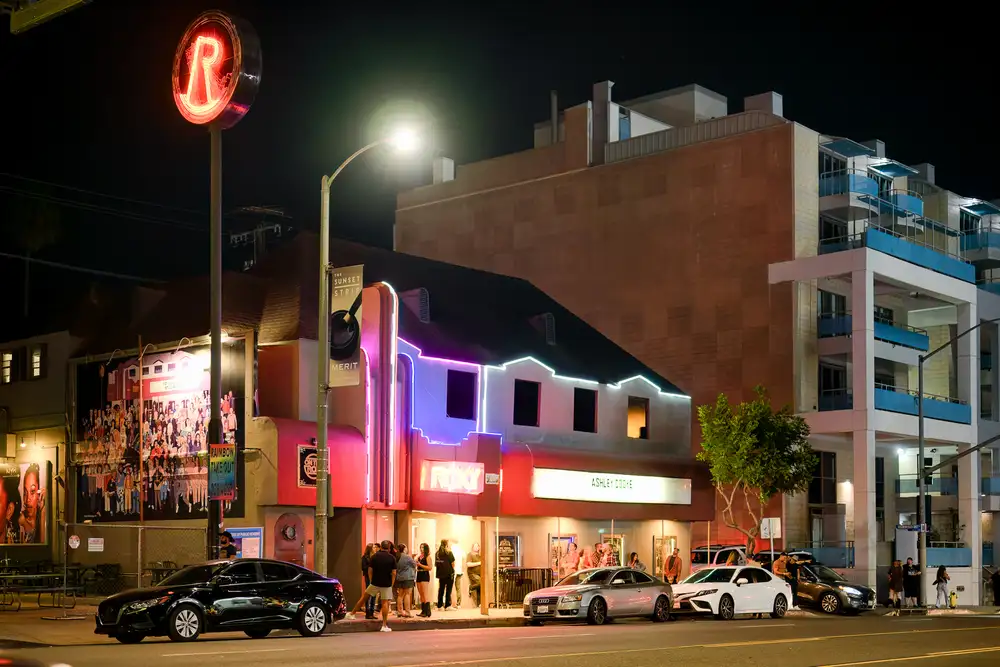
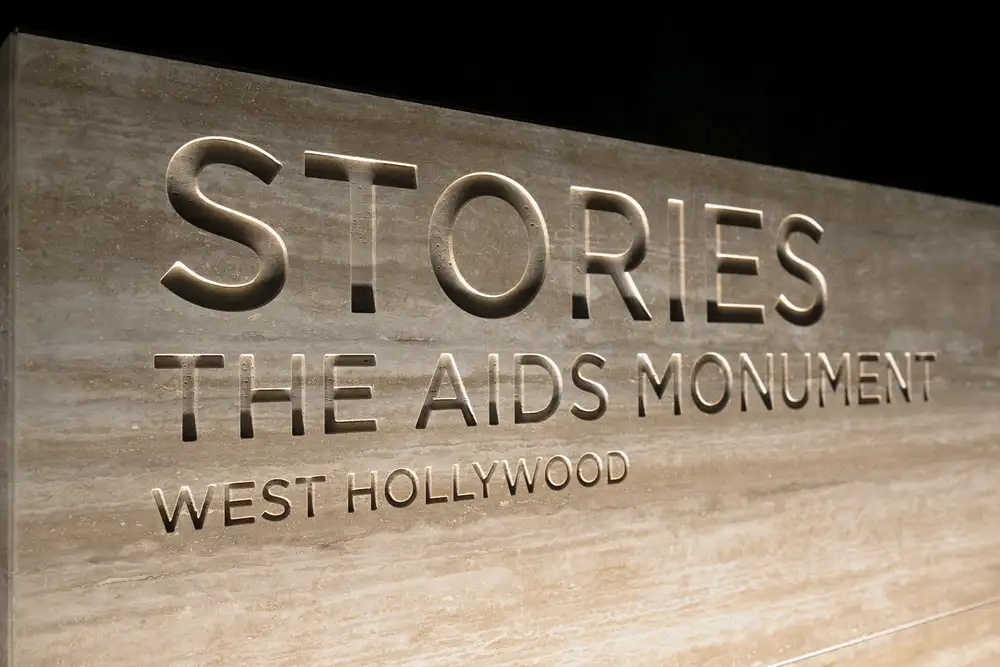
.webp)


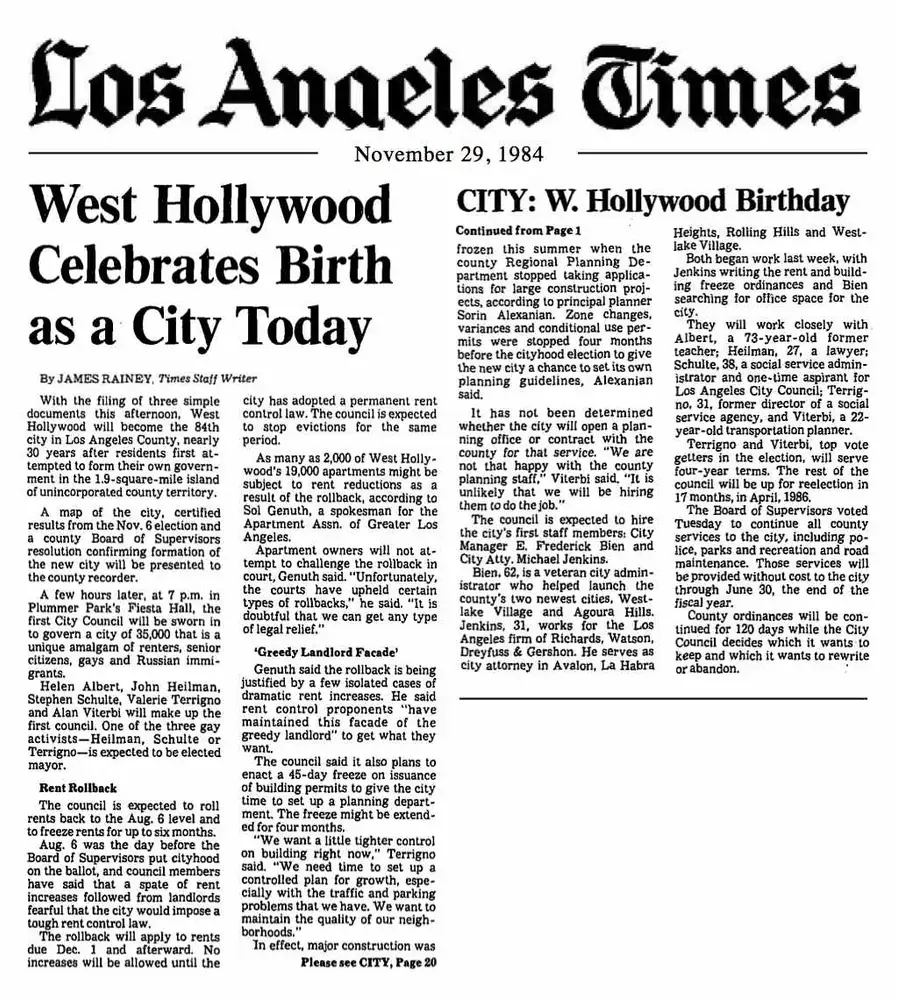
.webp)
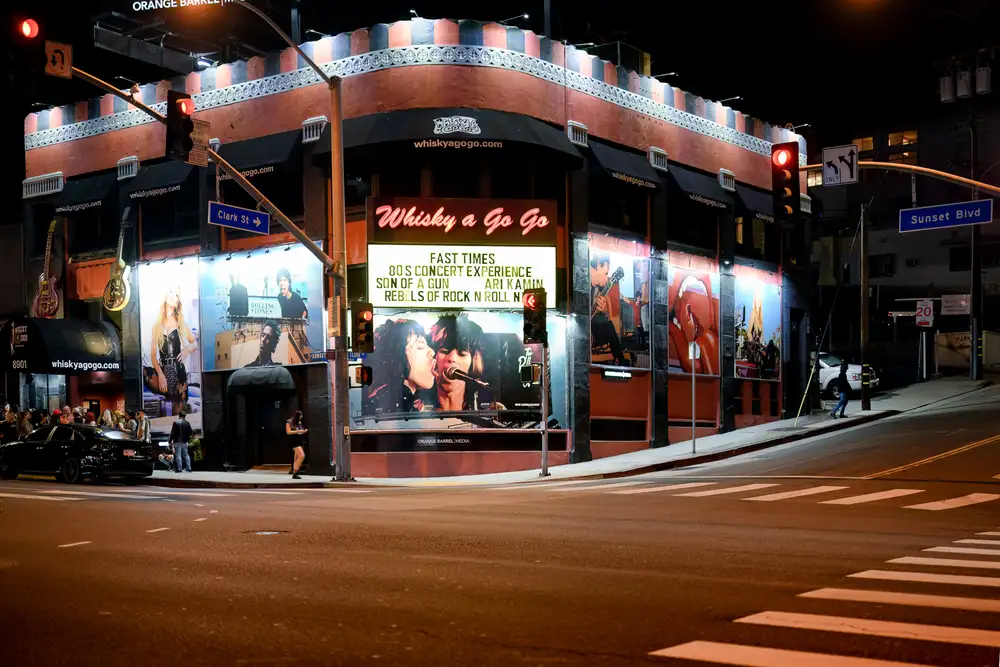

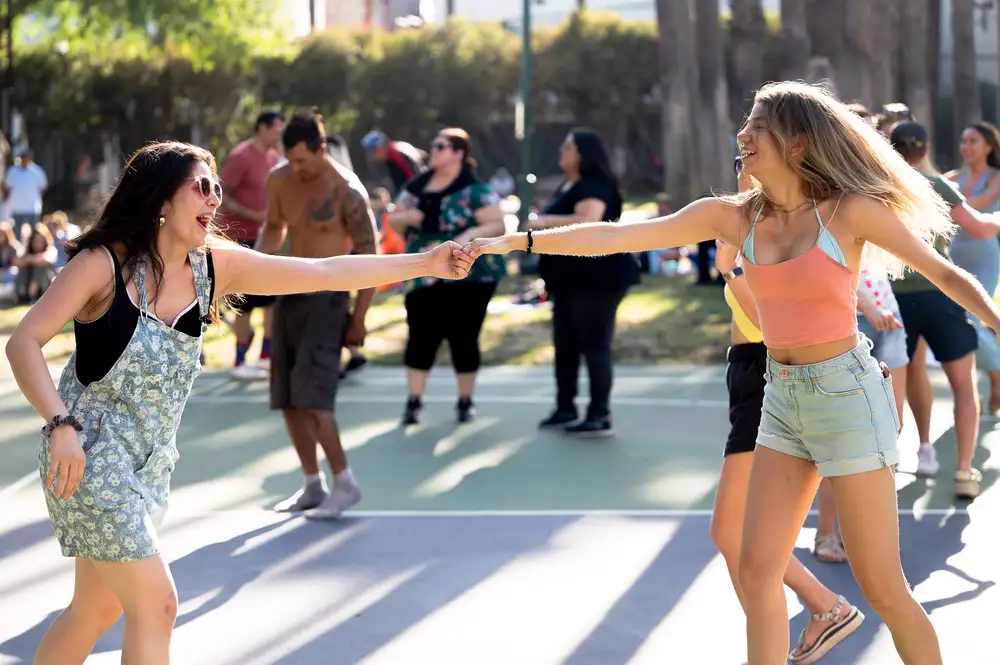
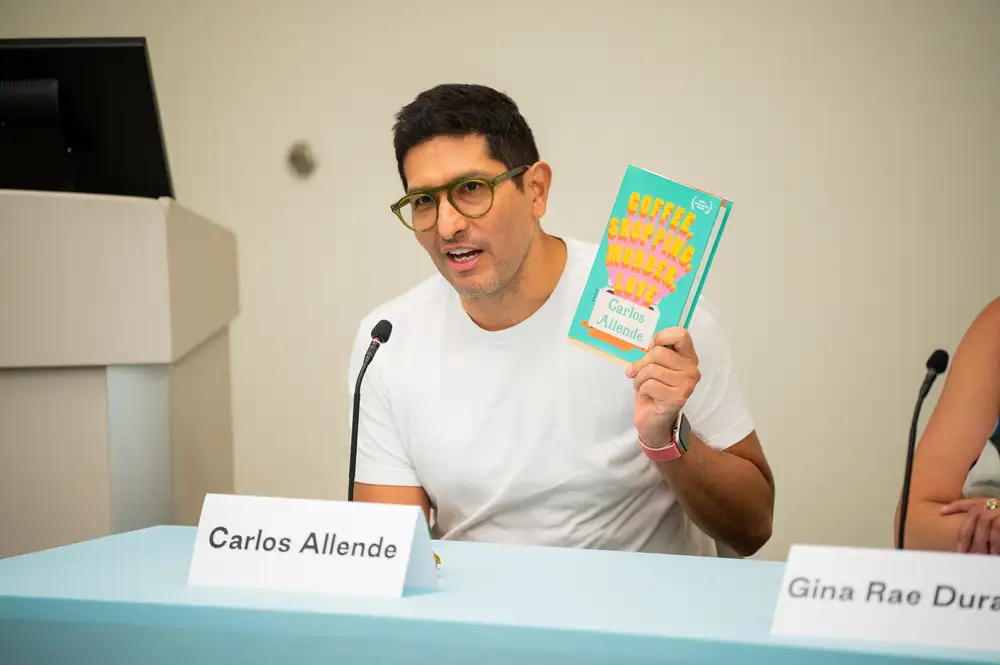

.png)


.webp)